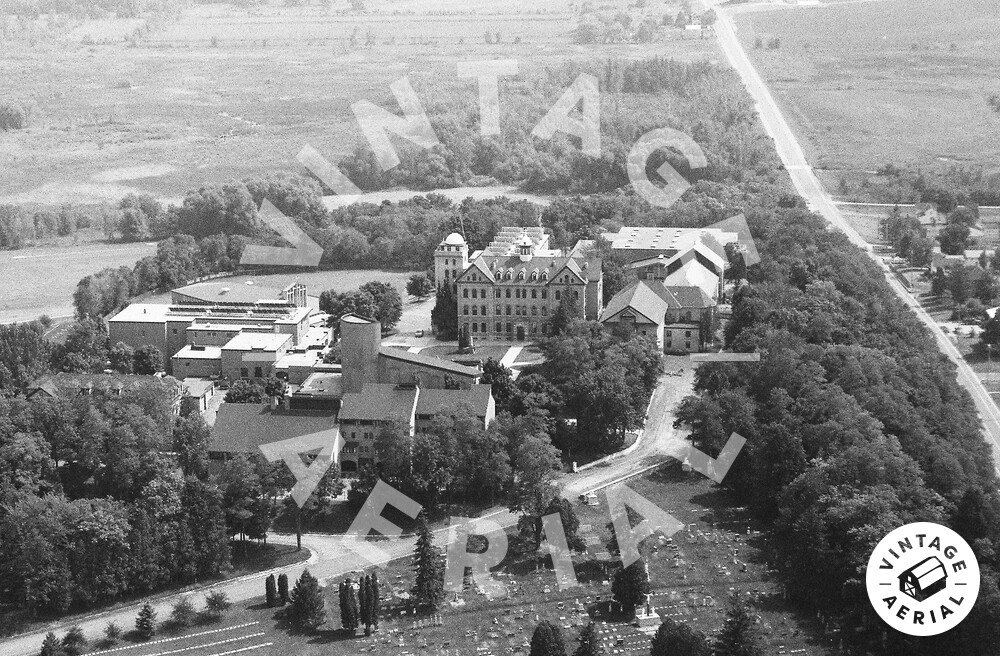Join Our Community
33,345 members are helping us to bring our collection to life.
Create a free Vintage Aerial account now to start commenting on photos, pinning locations, and earning points redeemable for our products!
Sign up now and receive a coupon for 10% off your first order!



Comments
This is St. Lawrence Seminary High School at 301 Church St on the Hill of Happiness in the Village of Mt. Calvary, Fond du Lac County, Wisconsin. In 1846, Fr. Casper Rehrl explored the Mt. Calvary area and selected the highest point in the area, the Hill of Happiness which was eventually to be used as the site of a log church. in 1849, Fr. Rehrl, the "Apostle to the Holyland" built a log church under the patronage of St. Nicholas the name was suggested because so many of the parishioners had the first name of Nicholas later on the church was renamed Holy Cross. On October 15, 1856, two Swiss diocesan priests, Rev. Fr. Francis Haas and Rev. Fr. Bonaventure Frey, arrived in Mt. Calvary, Wisconsin. Via horseback. Haas had been pastor in Kenosha, Wisconsin. and Frey had been a pastor in Milwaukee, Wisconsin. They had left Milwaukee that morning and traveled to Fond du Lac, where they hired two horses. The bishop had asked them to inspect Mt. Calvary to see if it was a suitable place to erect the first Capuchin friary. They followed a pioneer road from Calumet Harbor on Lake Winnebago toward the east. The going was hard through woods, skirting marshes, and through very hilly terrain. After some mistakes in direction and backtracking they finally arrived at the edge of what is now Mt. Calvary. They were impressed by the quiet solitude of the area, its sacred name, the hill, and on its peak the little church, amidst the towering oak trees. "Here we will build the first monastery" they said. They began building a small friary and convinced the Swiss Province of Capuchins to send two Capuchins from Switzerland to join them in Mount Calvary. Rev. Fr. Francis and Rev. Fr. Bonaventure also entered the Capuchin Order at this time. In 1858 a larger church with was built. In 1860, the Convent Latin School was opened as part of the friary. Four students enrolled. Tuition, room and board was $10 for the year. This event marks the beginning of St. Lawrence Seminary. In the fall of 1862, 15 students were enrolled, and 20 students began the following school year. A college wing was added to the friary in 1864, while enrollment climbed to 49 students. Yet another college wing was added in 1867. The friary and college now formed a quadrangle with a courtyard in the center. The 1868 school year opened with 28 Capuchin friars and 42 students in the newly-completed friary and college. Tragedy struck on Christmas night of 1868. A fire started in the sacristy and burned the entire complex to the ground, with the exception of part of the parish church. By 1870, the church and the rest of the complex were rebuilt. In 1872, another college building, Saint Joseph Hall, was erected. In 1881, the Laurentianum, the current main building, was built to include ample classroom space. By the time Fr. Francis died on June 21, 1895, having lived to see his dream of founding the Capuchin Order in the United States, Fr. Bonaventure was present at the fiftieth anniversary of the Capuchin foundation in the United States at Mount Calvary. When he died on July 4, 1912, his beloved St. Lawrence College was firmly established as a major educational institution in the Midwestern United States. Both men had lived long enough to see their hard work flourish into the beginnings of a great institution: St. Lawrence Seminary High School. Further improvements to the church came in the 1900’s. These included roof alterations from pitched to flat, installation of electric lights, and interior renovations. By 1920, these improvements had been completed. The church was located at the St. Lawrence Seminary site until 1968, when the decision was made to demolish it. In 1969, after approximately 100 years of service to Mt. Calvary, the old Holy Cross church, monastery, and tower were demolished. In 1970, the cornerstone was laid for a new, modern church. This new church was built west and across the road from the former location of St. Lawrence Seminary at 308 South County Road W (see 1994 Film Roll 25 Photo 25-YFO-12 and 1994 Film Roll 25 Photo 25-YFO-13). This church was renovated on the interior in 2006, and merged with St. Claudius Catholic Church (St. Cloud) and St. Joseph Catholic Church (St. Joe) in 2010. St. Isidore the Farmer Parish was created out of the merger. This church continues to hold regular Masses today. In the early morning hours of Saturday, March 8, 2014 a five-alarm fire broke out in St. Joseph's Hall. At 9:30 a.m. the second floor of St. Joseph's Hall collapsed causing the walls on the west end of the building to bulge and signaling the imminent end of the historic hall. A high-hoe arrived at 11 a.m. And tipped the walls into a pile at the middle of the structure. This move saved the Laurentianum and the north wall of St. Joseph's Hall adorned with the Statue of St. Joseph. Looking south. This is the same location as 1977 Film Roll 101 Photo 101-PFON-32 and 1994 Film Roll 24 Photo 24-YFO-1.